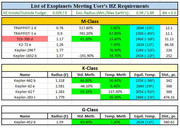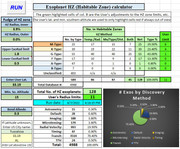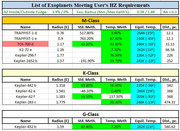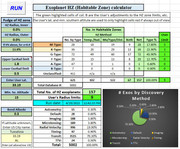Rod, that is an interesting point. Of course, many Jupiter size planets would look very much like Earth or Venus (themselves not exactly congruent

) at other points in the development of their stars. (OR Mercury or Mars, for that matter).
Helio, please, (and/or Rod), Is any account taken when making such comments as the what might be the case at other development stages of their stars?
Please pardon my ignorance in this matter, which is not currently close to my core interests.
Cat



Cat, in answer to *Is any account taken when making such comments as the what might be the case at other development stages of their stars?*
It seems so, however I note with much difficulty like this report. ALMA constraints on assembly of Core Accretion planets,
https://arxiv.org/abs/2204.05372, and reference paper,
https://arxiv.org/pdf/2204.05372.pdf, 11-April-2022, 17-pages.
This was refreshing for me to see.
"1 INTRODUCTION A planet formation theory is a set of equations describing evolution of planet variables, such as its mass Mp, separation a, metallicity zp, etc., inside the parent protoplanetary disc. Protoplanetary disc evolution is itself a field of intense research (Williams & Cieza 2011; Alexander et al. 2014), with data indicating a tremendous variety in protoplanetary disc properties even for stars of similar mass, age, and environment (e.g., Manara et al. 2017; Andrews 2020). Furthermore, exoplanetary data are very strongly dominated by planets orbiting stars much older than ∼ 10 Myr (e.g., Winn & Fabrycky 2015). These stars have lost all signs of their primordial discs from which they grew. This makes it impossible to ascertain the properties of the disc in which a given planet formed. We also face similar uncertainties for the planets in the Solar System..."
It is clear that the *primordial discs* for the majority of exoplanets documented today, is not seen in astronomy but assumed to be there in the unobserved past *to fit with the theory* and computer simulations using accretion discs around *young stars*. This is true for the solar nebula and how the MMSN (Minimum Mass Solar Nebula) is used in computer models to explain how our solar system formed. Seldom do I find this clearly acknowledged. The computer simulations commonly create numerous unobserved objects in nature today, a classic example is Theia used in the giant impact model to explain the origin of our Moon or a variety of proto-planetary cores near 5 to 10 earth masses to simulate the evolution of ice giants like Uranus or Neptune, even Jupiter, Saturn. We do not see the MMSN in the ecliptic today or proto-planets or even planet embryos in our solar system, language found in the computer models.
So Cat, the effort is there but explaining how a 1.1 solar mass star, perhaps near 8 Gyr old with unobserved primordial disc today, gave birth to an exoplanet near 2.76 Jupiter mass in a location in the system where Venus and Earth are in our solar system moving around the Sun, 1 solar mass star is challenging. Somehow these interesting exoplanet configurations managed to not appear in our solar system, and thus, somehow you and I can live and read interesting issues like this













